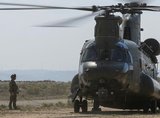Synthetic training capability demonstrated to UK Royal Navy
HMS Queen Elizabeth took part in a Phase Two demonstration of the Platform Enabled Training Capability. (Photo: UK MoD/Crown Copyright)
QinetiQ, Inzpire and BAE Systems delivered a further demonstration under Phase 2 of the PETC to the Royal Navy. The complex synthetic collective training demonstration was operated from Portsdown Technology Park delivering training to three platforms docked at HM Naval Base Portsmouth: HMS Kent, HMS Diamond and HMS Queen Elizabeth, operating together.
Connecting into the three platforms simultaneously via satellite communications, the consortium enabled the delivery of a synthetic collective training environment, through scenarios adapted and delivered by a dynamic White Force. This allowed the crews of the three ships to conduct realistic training against a peer adversary.
Alongside representatives from the companies, the demonstration was attended by a team from Fleet Operational Standards and Training and a number of high-ranking RN personnel.
Related Articles
QinetiQ to demonstrate synthetic training for Royal Navy at I/ITSEC 2022
As an alternative to fully live or shore-based synthetic training, PETC enables the RN to demonstrate how synthetics can be used to create an immersive training environment within a ship’s own operations room.
The use of this environment aims to allow for the delivery of training whilst on deployment, across a number of vessels that may not be geographically close by, presenting opportunities for ships from multiple international forces to practice training together.
PETC therefore aims to provide more opportunities for training alongside international partners within a wartime environment, whilst offering significant time and cost savings to the customer, as well as environmental benefits due to the ships and crews not having to travel to the same extent for the synthetic collective training, compared with live training.
Shephard's DSEI 2023 coverage is sponsored by:

More from DSEI 2023 | View all news
-
![The Joint Light Tactical Vehicle continues its success as the new variant rolls out]()
The Joint Light Tactical Vehicle continues its success as the new variant rolls out
The Joint Light Tactical Vehicle (JLTV) is becoming the dominant platform in its class as it replaces most of the massive US Army and US Marine Corps (USMC) fleets of HMMWV 4x4s, colloquially known as the Humvee. Shephard dives deep into the JLTV programme background and analyses the latest variants and contracts, including the controversial production switch to AM General and the continued contracts continuing to head Oshkosh's way.
-
![Dubai Airshow 2023: How the MQ-9 Reaper UAS came to rule the skies]()
Dubai Airshow 2023: How the MQ-9 Reaper UAS came to rule the skies
Ahead of the 2023 edition of the Dubai Airshow, Shephard looks at the GA-ASI MQ-9A Reaper UAS, its role in shaping modern conflict dynamics, and its deployment for surveillance and precision strike throughout the Middle East.
-
![Orbiting the Future: How New Satellite Technologies are Revolutionising Global Communications]()
Orbiting the Future: How New Satellite Technologies are Revolutionising Global Communications
With the satellite industry at a pivotal juncture, Intelsat is investing in advanced technologies like 5G and optical communications, striving to enhance worldwide connectivity and address emerging governmental needs.
-
![CH-47 Chinook: why the timeless helicopter design is still a heavy-lift contender on the modern battlefield]()
CH-47 Chinook: why the timeless helicopter design is still a heavy-lift contender on the modern battlefield
From its emergence as a ground-breaking design in the 1950s to its widespread deployment in diverse operations worldwide, the Chinook continues to leave an indelible mark on the aviation landscape. Shephard sums up the latest developments and tells you everything you need to know about the workhorse of many armies and air forces in the 2020s.
-
DSEI 2023: Controp unveils Smart Vision AI software for EO/IR payloads
Controp Precision Technologies unveiled its Smart Vision AI software for enhancing the level of autonomy and automation for a variety of surveillance and reconnaissance missions at DSEI 2023.
-
![Babcock and Cosworth to test hybrid propulsion in militarised Land Cruiser 70]()
Babcock and Cosworth to test hybrid propulsion in militarised Land Cruiser 70
Babcock has signed an MoU with propulsion experts Cosworth to investigate the use of hybrid power systems in military vehicles and will begin with integrating a Catalytic Generator (Cat Gen) into a 70 Series Toyota Land Cruiser.



























